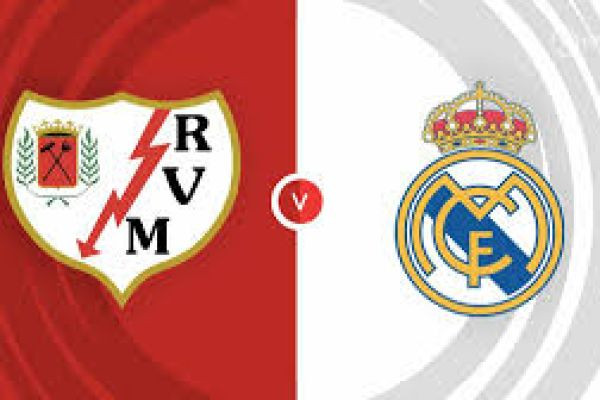The fixture between Rayo Vallecano and Real Madrid CF is more than just a match; it is a clash of two footballing worlds within the Spanish capital. It is a genuine derby that pits the global, star-studded enterprise of the Blancos against the fierce, localized, and anti-establishment spirit of the Rayo Franja (the Sash). When played at the intimate and hostile Estadio de Vallecas, this contest becomes one of the toughest tactical puzzles for Real Madrid, often forcing them to fight tooth and nail for three points.
Real Madrid: Controlling Chaos with Elite Quality
Real Madrid's tactical mandate is always rooted in possession and dominance, but against Rayo, their focus shifts to handling extreme pressure. Carlo Ancelotti typically deploys a flexible $4-3-3$ or a $4-4-2$ diamond, relying on technical superiority to break the lines.
Real Madrid’s Strategic Pillars:
Midfield Breakout: The ability of Real’s deep midfielders (such as Aurélien Tchouaméni or Eduardo Camavinga) to maintain composure and execute quick, short passes under the suffocating pressure of Rayo’s press is paramount. If they can bypass the first two lines of pressure, massive space opens up behind Rayo's aggressive structure.
Vini Jr.'s Decisiveness: Vinícius Júnior is often the primary outlet. His pace and dribbling skills are used to turn a defensive clearance into an immediate attacking overload. He is tasked with creating goal-scoring chances in isolation, particularly against a Rayo right-back who will be constantly high-pressed.
Bellingham’s Penetration: The movement of Jude Bellingham from midfield is key to exploiting the channels that Rayo’s high press inevitably leaves open. His late runs into the box and ability to operate in the half-spaces punish the slightest lack of concentration in the Rayo defense.
The Vulnerability: Real Madrid's attack-minded full-backs (Dani Carvajal and Ferland Mendy/Fran García) often leave significant space behind them. If Rayo's press wins the ball, their vertical transition immediately targets these empty zones, forcing Real Madrid’s center-backs into exposed one-on-one situations.
Rayo Vallecano: The High-Intensity, Man-Marking Press
Rayo's tactical identity is defined by intensity and confrontation. Under their various modern coaches, the team has consistently employed a high-risk, high-reward man-marking press out of a $4-2-3-1$ or $4-4-2$ shape.
Rayo’s Strategic Mandate:
Suffocate the Build-Up: Rayo’s press is not zonal; it’s highly aggressive and man-oriented. Forwards and midfielders relentlessly track their Real Madrid counterparts, aiming to disrupt the passing rhythm and force the center-backs to make risky long balls or lose possession in dangerous areas. They particularly target the deep pivot to prevent the ball from reaching the advanced creators.
Verticality on Turnover: When the ball is won (and they will win it high up the pitch), Rayo immediately plays vertically. There is little time wasted; the ball is moved quickly to the most advanced runner, often a winger or a striker (like Raúl de Tomás), to take advantage of Real Madrid's structural disorganization.
Embrace the Chaos: The atmosphere in Vallecas demands intensity. Rayo's players feed off this energy, accepting that the game will be scrappy, physical, and played at a frenetic tempo. Their goal is to prevent Real Madrid from ever settling into their comfortable, rhythmic passing game.
The Weakness: Rayo's system is highly physically demanding. If Real Madrid manages to withstand the press for long periods, Rayo’s defensive intensity wanes dramatically in the second half, and the man-marking system can be easily pulled apart by decoy runs.
Key Decisive Tactical Conflicts
The outcome of this derby will hinge on three specific duels:
The Midfield War Zone: The duel between Real Madrid's pivot (Tchouaméni/Camavinga) and Rayo's pressing duo (e.g., Unai López/Óscar Valentín). If Rayo's intensity forces errors, they control the match. If Real's technical quality breaks the lines, they control the space.
Vini Jr. vs. The Rayo Right-Side: This individual battle is pivotal. Vini Jr. must use his pace to exploit the high position of the Rayo right-back, but the Rayo winger and central midfielder must provide diligent cover to prevent him from achieving isolation near the penalty area.
Set-Pieces and Physicality: In a tight, intense match, set-pieces will be key. Rayo's aggressive style often leads to conceded free-kicks, and Real Madrid's aerial superiority (especially with Éder Militão or Antonio Rüdiger) is a constant threat that Rayo must neutralize.
Cultural Context and Prediction
The atmosphere at Vallecas is unique in La Liga. The Bukaneros ultras create a raw, politically charged, and deafening environment that is hostile to the champions of Europe. For Rayo, beating Real Madrid is a statement of identity—a victory for the neighborhood. For Real Madrid, it's about pure institutional pressure; anything less than three points is viewed as a crisis.
Expect a high-energy, physical start where Rayo dominates the intensity and attempts to overwhelm Real Madrid with their press. Real Madrid will rely on their individual quality and superior technical composure to weather the storm. While Rayo always makes it difficult, Real Madrid’s elite depth and the ability of players like Bellingham and Vini Jr. to win isolated duels usually provides the necessary breakthrough. A final score of $0-1$ or $1-2$ in favor of Real Madrid is the most likely outcome, achieved only after surviving a furious hour of play.








